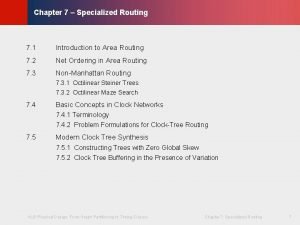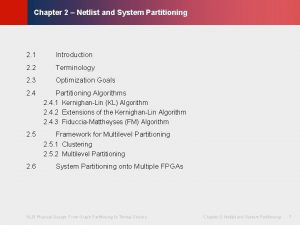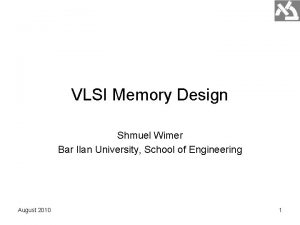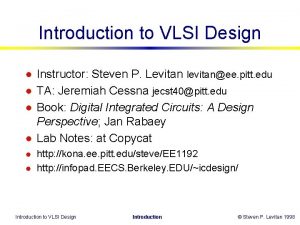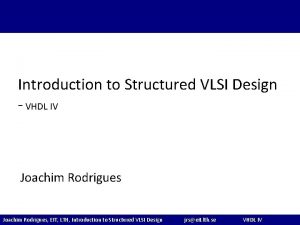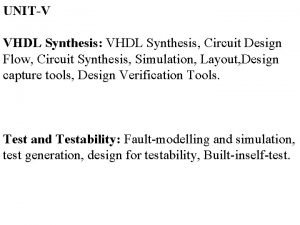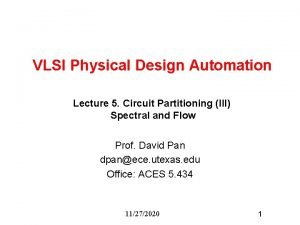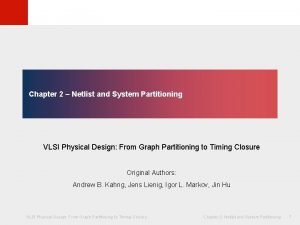KLMH Chapter 7 Specialized Routing VLSI Physical Design





























































- Slides: 61

© KLMH Chapter 7 – Specialized Routing VLSI Physical Design: From Graph Partitioning to Timing Closure Original Authors: VLSI Physical Design: From Graph Partitioning to Timing Closure Chapter 7: Specialized Routing Lienig Andrew B. Kahng, Jens Lienig, Igor L. Markov, Jin Hu

© KLMH Chapter 7 – Specialized Routing 7. 1 Introduction to Area Routing 7. 2 Net Ordering in Area Routing 7. 3 Non-Manhattan Routing 7. 3. 1 Octilinear Steiner Trees 7. 3. 2 Octilinear Maze Search 7. 4 Basic Concepts in Clock Networks 7. 4. 1 Terminology 7. 4. 2 Problem Formulations for Clock-Tree Routing 7. 5 Modern Clock Tree Synthesis VLSI Physical Design: From Graph Partitioning to Timing Closure Chapter 7: Specialized Routing 2 Lienig 7. 5. 1 Constructing Trees with Zero Global Skew 7. 5. 2 Clock Tree Buffering in the Presence of Variation

Specialized Routing © KLMH 7 System Specification Partitioning Architectural Design ENTITY test is port a: in bit; end ENTITY test; Functional Design and Logic Design Chip Planning Circuit Design Placement Physical Design DRC LVS ERC Physical Verification and Signoff Clock Tree Synthesis Signal Routing Fabrication Timing Closure Packaging and Testing VLSI Physical Design: From Graph Partitioning to Timing Closure Chapter 7: Specialized Routing 3 Lienig Chip

Specialized Routing © KLMH 7 Routing Global Routing Detailed Routing Timing-Driven Routing Large Single. Net Routing Geometric Techniques Coarse-grain assignment of routes to routing regions (Chap. 5) Fine-grain assignment of routes to routing tracks (Chap. 6) Net topology optimization and resource allocation to critical nets (Chap. 8) Power (VDD) and Ground (GND) routing (Chap. 3) Non-Manhattan and clock routing (Chap. 7) VLSI Physical Design: From Graph Partitioning to Timing Closure Chapter 7: Specialized Routing 4 Lienig Multi-Stage Routing of Signal Nets

Specialized Routing © KLMH 7 · Area routing directly constructs metal routes for signal connections (no global and detailed routing, Secs. 7. 1 -7. 2) · Non-Manhattan routing is presented in Sec. 7. 3 VLSI Physical Design: From Graph Partitioning to Timing Closure Chapter 7: Specialized Routing 5 Lienig · Clock signals and other nets that require special treatment are discussed in Secs. 7. 4 -7. 5

Introduction to Area Routing © KLMH 7. 1 · The goal of area routing is to route all nets in the design - without global routing - within the given layout space - while meeting all geometric and electrical design rules · Area routing performs the following optimizations - minimizing the total routed length and number of vias of all nets minimizing the total area of wiring and the number of routing layers minimizing the circuit delay and ensuring an even wire density avoiding harmful capacitive coupling between neighboring routes · Subject to VLSI Physical Design: From Graph Partitioning to Timing Closure Chapter 7: Specialized Routing 6 Lienig - technology constraints (number of routing layers, minimal wire width, etc. ) - electrical constraints (signal integrity, coupling, etc. ) - geometry constraints (preferred routing directions, wire pitch, etc. )

Introduction to Area Routing © KLMH 7. 1 Alternative routing path: Minimal wirelength: 4 1 1 IC 1 4 IC 3 1 IC 2 4 Metal 1 Metal 2 VLSI Physical Design: From Graph Partitioning to Timing Closure Chapter 7: Specialized Routing 7 Lienig Via

Introduction to Area Routing © KLMH 7. 1 Distance metric between two points P 1 (x 1, y 1) and P 2 (x 2, y 2) Euclidean distance Manhattan distance P 1 d. M d. E P 2 VLSI Physical Design: From Graph Partitioning to Timing Closure Chapter 7: Specialized Routing 8 Lienig d. M

Introduction to Area Routing © KLMH 7. 1 Multiple Manhattan shortest paths between two points VLSI Physical Design: From Graph Partitioning to Timing Closure Chapter 7: Specialized Routing 9 Lienig ·

Introduction to Area Routing © KLMH 7. 1 · Multiple Manhattan shortest paths between two points m = 210 y x VLSI Physical Design: From Graph Partitioning to Timing Closure Chapter 7: Specialized Routing 10 Lienig With no obstacles, the number of Manhattan shortest paths in an Δx × Δy region is

Introduction to Area Routing © KLMH 7. 1 Two pairs of points may admit non-intersecting Manhattan shortest paths, while their Euclidean shortest paths intersect (but not vice versa). VLSI Physical Design: From Graph Partitioning to Timing Closure Chapter 7: Specialized Routing 11 Lienig ·

Introduction to Area Routing © KLMH 7. 1 If all pairs of Manhattan shortest paths between two pairs of points intersect, then so do Euclidean shortest paths. VLSI Physical Design: From Graph Partitioning to Timing Closure Chapter 7: Specialized Routing 12 Lienig ·

Introduction to Area Routing © KLMH 7. 1 · The Manhattan distance d. M is (slightly) larger than the Euclidean distance d. E: 1. 41 worst case: a square where 1. 27 on average, without obstacles VLSI Physical Design: From Graph Partitioning to Timing Closure Chapter 7: Specialized Routing 13 Lienig 1. 15 on average, with obstacles

Net Ordering in Area Routing © KLMH 7. 2 7. 1 Introduction to Area Routing 7. 2 Net Ordering in Area Routing 7. 3 Non-Manhattan Routing 7. 3. 1 Octilinear Steiner Trees 7. 3. 2 Octilinear Maze Search 7. 4 Basic Concepts in Clock Networks 7. 4. 1 Terminology 7. 4. 2 Problem Formulations for Clock-Tree Routing 7. 5 Modern Clock Tree Synthesis VLSI Physical Design: From Graph Partitioning to Timing Closure Chapter 7: Specialized Routing 14 Lienig 7. 5. 1 Constructing Trees with Zero Global Skew 7. 5. 2 Clock Tree Buffering in the Presence of Variation

Net Ordering in Area Routing © KLMH 7. 2 Effect of net ordering on routability A B A´ B´ B´ Optimal routing of net B A´ B´ Nets A and B can be routed only with detours VLSI Physical Design: From Graph Partitioning to Timing Closure Chapter 7: Specialized Routing 15 Lienig © 2011 Springer Verlag Optimal routing of net A A´ A B

Net Ordering in Area Routing © KLMH 7. 2 Effect of net ordering on total wirelength A A B B B´ B´ A´ Routing net B first VLSI Physical Design: From Graph Partitioning to Timing Closure Chapter 7: Specialized Routing 16 Lienig © 2011 Springer Verlag Routing net A first A´

Net Ordering in Area Routing © KLMH 7. 2 · For n nets, there are n! possible net orderings VLSI Physical Design: From Graph Partitioning to Timing Closure Chapter 7: Specialized Routing 17 Lienig Þ Constructive heuristics are used

Net Ordering in Area Routing © KLMH 7. 2 · Rule 1: For two nets i and j, if aspect ratio (i ) > aspect ratio (j ), then i is routed before j A A B´ B Net A has a higher aspect ratio of its bounding box; routing A first results in shorter total wirlength VLSI Physical Design: From Graph Partitioning to Timing Closure A´ B Routing net B first results in longer total wirelength Chapter 7: Specialized Routing © 2011 Springer Verlag A´ 18 Lienig B´

Net Ordering in Area Routing © KLMH 7. 2 · Rule 2: For two nets i and j, if the pins of i are contained within MBB(j ), then i is routed before j Net Ordering A C A A B D C´ D′ B D B′ A′ Ordering D-A-C-B or D-C-B-A (not D-B-A-C) B D C´ C VLSI Physical Design: From Graph Partitioning to Timing Closure C D′ B′ A′ Chapter 7: Specialized Routing 19 Lienig Constraint Graph

Net Ordering in Area Routing © KLMH 7. 2 · Rule 3: Let (net) be the number of pins within MBB(net) for net. For two nets i and j, if (i ) < (j ), then i is routed before j. For each net, consider the pins of other nets within its bounding box - The net with the smallest number of such pins is routed first - Ties are broken based on the number of pins that are contained within the bounding box and on its edge B A C D Pins Inside (Edge) D´ A´ E C´ E´ MBB (A) B C D E B´ VLSI Physical Design: From Graph Partitioning to Timing Closure D (B, C, D) - (A) - (-) - (A, C) B C (net) 3 3 1 0 2 D D´ A´ E C´ E´ B´ Chapter 7: Specialized Routing 20 Lienig A -

Non-Manhattan Routing © KLMH 7. 3 7. 1 Introduction to Area Routing 7. 2 Net Ordering in Area Routing 7. 3 Non-Manhattan Routing 7. 3. 1 Octilinear Steiner Trees 7. 3. 2 Octilinear Maze Search 7. 4 Basic Concepts in Clock Networks 7. 4. 1 Terminology 7. 4. 2 Problem Formulations for Clock-Tree Routing 7. 5 Modern Clock Tree Synthesis VLSI Physical Design: From Graph Partitioning to Timing Closure Chapter 7: Specialized Routing 21 Lienig 7. 5. 1 Constructing Trees with Zero Global Skew 7. 5. 2 Clock Tree Buffering in the Presence of Variation

Non-Manhattan Routing © KLMH 7. 3 · Allow 45 - or 60 -degree segments in addition to horizontal and vertical segments · λ-geometry, where λ represents the number of possible routing directions and the angles / λ at which they can be oriented - λ = 2 (90 degrees): Manhattan routing (four routing directions) - λ = 3 (60 degrees): Y-routing (six routing directions) - λ = 4 (45 degrees): X-routing (eight routing directions) VLSI Physical Design: From Graph Partitioning to Timing Closure Chapter 7: Specialized Routing 22 Lienig · Non-Manhattan routing is primarily employed on printed circuit boards (PCBs)

Octilinear Steiner Trees © KLMH 7. 3. 1 · Route planning using octilinear Steiner minimum trees (OSMT) · Generalize rectilinear Steiner trees by allowing segments that extend in eight directions · More freedom when placing Steiner points 1 3 2 5 4 7 10 11 9 © 2011 Springer Verlag 8 12 VLSI Physical Design: From Graph Partitioning to Timing Closure Chapter 7: Specialized Routing 23 Lienig 6

Octilinear Steiner Trees © KLMH 7. 3. 1 Octilinear Steiner Tree Algorithm Output: heuristic octilinear minimum Steiner tree OST = Ø T = set of all three-pin nets of P found by Delaunay triangulation sorted. T = SORT(T, minimum octilinear distance) for (i = 1 to |sorted. T |) sub. T = ROUTE(sorted. T [i ] ) // route minimum tree over sub. T ADD(OST, sub. T ) // add route to existing tree IMPROVE(OST, sub. T ) // locally improve OST based on sub. T VLSI Physical Design: From Graph Partitioning to Timing Closure Chapter 7: Specialized Routing 24 Lienig T. -Y. ; Chang, et. al. : Multilevel Full-Chip Routing for the X-Based Architecture Input: set of all pins P and their coordinates

Octilinear Steiner Trees © KLMH 7. 3. 1 (1) Triangulate 1 1 3 2 5 4 9 10 11 9 12 © 2011 Springer Verlag 12 8 VLSI Physical Design: From Graph Partitioning to Timing Closure Chapter 7: Specialized Routing 25 Lienig 11 7 6 8 10 5 4 7 6 3 2

Octilinear Steiner Trees © KLMH 7. 3. 1 (2) Add route to existing tree (1) Triangulate 1 3 2 5 8 7 9 12 11 7 6 8 10 5 4 9 12 8 10 11 9 12 VLSI Physical Design: From Graph Partitioning to Timing Closure Chapter 7: Specialized Routing 26 Lienig © 2011 Springer Verlag 10 5 6 3 2 4 7 6 3 2 4 11 1 1

Octilinear Steiner Trees © KLMH 7. 3. 1 (2) Add route to existing tree 1 3 2 5 8 11 5 9 12 11 9 12 8 10 11 cost = 6 VLSI Physical Design: From Graph Partitioning to Timing Closure 7 6 8 10 5 4 7 6 3 2 4 7 10 3 2 4 6 1 cost ≈ 5. 7 Chapter 7: Specialized Routing 9 12 © 2011 Springer Verlag 1 (3) Locally improve OST 27 Lienig (1) Triangulate

Octilinear Steiner Trees © KLMH 7. 3. 1 Final OST after merging all subtrees (3) Locally improve OST 1 1 3 2 5 4 8 9 12 10 11 9 12 VLSI Physical Design: From Graph Partitioning to Timing Closure Chapter 7: Specialized Routing 28 Lienig © 2011 Springer Verlag 11 7 6 8 10 5 4 7 6 3 2

Octilinear Maze Search © KLMH 7. 3. 2 2 2 3 3 2 3 2 2 2 3 2 1 1 1 2 1 S 1 2 3 2 1 S 1 2 1 1 1 2 3 2 1 1 1 2 2 2 3 T 3 3 1 T T Expansion (2) Backtracing VLSI Physical Design: From Graph Partitioning to Timing Closure Chapter 7: Specialized Routing 29 Lienig © 2011 Springer Verlag Expansion (1) 1

Octilinear Maze Search © KLMH 7. 3. 2 S VLSI Physical Design: From Graph Partitioning to Timing Closure Chapter 7: Specialized Routing 30 Lienig T

Basic Concepts in Clock Networks © KLMH 7. 4 7. 1 Introduction to Area Routing 7. 2 Net Ordering in Area Routing 7. 3 Non-Manhattan Routing 7. 3. 1 Octilinear Steiner Trees 7. 3. 2 Octilinear Maze Search 7. 4 Basic Concepts in Clock Networks 7. 4. 1 Terminology 7. 4. 2 Problem Formulations for Clock-Tree Routing 7. 5 Modern Clock Tree Synthesis VLSI Physical Design: From Graph Partitioning to Timing Closure Chapter 7: Specialized Routing 31 Lienig 7. 5. 1 Constructing Trees with Zero Global Skew 7. 5. 2 Clock Tree Buffering in the Presence of Variation

Terminology © KLMH 7. 4. 1 · A clock routing instance (clock net) is represented by n+1 terminals, where s 0 is designated as the source, and S = {s 1, s 2, … , sn} is designated as sinks - Let si, 0 ≤ i ≤ n, denote both a terminal and its location · A clock routing solution consists of a set of wire segments that connect all terminals of the clock net, so that a signal generated at the source propagates to all of the sinks - Two aspects of clock routing solution: topology and geometric embedding · The clock-tree topology (clock tree) is a rooted binary tree G with n leaves corresponding to the set of sinks VLSI Physical Design: From Graph Partitioning to Timing Closure Chapter 7: Specialized Routing 32 Lienig - Internal nodes = Steiner points

Terminology © KLMH 7. 4. 1 Connection topology s 0 s 1 s 2 s 6 u 3 u 1 s 0 s 2 s 3 VLSI Physical Design: From Graph Partitioning to Timing Closure s 3 u 4 s 5 u 3 u 2 s 4 s 6 s 5 u 4 s 6 © 2011 Springer Verlag s 5 s 4 s 1 u 1 s 2 u 2 s 0 s 3 Embedding Chapter 7: Specialized Routing 33 Lienig Clock routing problem instance

Terminology © KLMH 7. 4. 1 · Clock skew: (maximum) difference in clock signal arrival times between sinks · Local skew: maximum difference in arrival times of the clock signal at the clock pins of two or more related sinks - Sinks within distance d > 0 - Flip-flops or latches connected by a directed signal path · Global skew: maximum difference in arrival times of the clock signal at the clock pins of any two (related or unrelated) sinks - Difference between shortest and longest source-sink path delays in the clock distribution network VLSI Physical Design: From Graph Partitioning to Timing Closure Chapter 7: Specialized Routing 34 Lienig - The term “skew” typically refers to “global skew”

Problem Formulations for Clock-Tree Routing © KLMH 7. 4. 2 · Zero skew: zero-skew tree (ZST) - ZST problem · Bounded skew: true ZST may not be necessary in practice - Signoff timing analysis is sufficient with a non-zero skew bound - In addition to final (signoff) timing, this relaxation can be useful with intermediate delay models when it facilitates reductions in the length of the tree - Bounded-Skew Tree (BST) problem · Useful skew: correct chip timing only requires control of the local skews between pairs of interconnected flip-flops or latches VLSI Physical Design: From Graph Partitioning to Timing Closure Chapter 7: Specialized Routing 35 Lienig - Useful skew formulation is based on analysis of local skew constraints

Modern Clock Tree Synthesis © KLMH 7. 5 7. 1 Introduction to Area Routing 7. 2 Net Ordering in Area Routing 7. 3 Non-Manhattan Routing 7. 3. 1 Octilinear Steiner Trees 7. 3. 2 Octilinear Maze Search 7. 4 Basic Concepts in Clock Networks 7. 4. 1 Terminology 7. 4. 2 Problem Formulations for Clock-Tree Routing 7. 5 Modern Clock Tree Synthesis VLSI Physical Design: From Graph Partitioning to Timing Closure Chapter 7: Specialized Routing 36 Lienig 7. 5. 1 Constructing Trees with Zero Global Skew 7. 5. 2 Clock Tree Buffering in the Presence of Variation

Modern Clock Tree Synthesis © KLMH 7. 5 · A clock tree should have low skew, while delivering the same signal to every sequential gate · Clock tree synthesis is performed in two steps: (1) Initial tree construction (Sec. 7. 5. 1) with one of these scenarios - Construct a regular clock tree, largely independent of sink locations - Simultaneously determine a topology and an embedding - Construct only the embedding, given a clock-tree topology as input VLSI Physical Design: From Graph Partitioning to Timing Closure Chapter 7: Specialized Routing 37 Lienig (2) Clock buffer insertion and several subsequent skew optimizations (Sec. 7. 5. 2)

Constructing Trees with Zero Global Skew © KLMH 7. 5. 1 H-tree - Blockages can spoil the symmetry of an H-tree - Non-uniform sink locations and varying sink capacitances also complicate the design of H-trees VLSI Physical Design: From Graph Partitioning to Timing Closure Chapter 7: Specialized Routing 38 Lienig · Used for top-level clock distribution, not for the entire clock tree © 2011 Springer Verlag · Exact zero skew due to the symmetry of the H-tree

Constructing Trees with Zero Global Skew © KLMH 7. 5. 1 Method of Means and Medians (MMM) · Can deal with arbitrary locations of clock sinks · Basic idea: - Recursively partition the set of terminals into two subsets of equal size (median) VLSI Physical Design: From Graph Partitioning to Timing Closure Chapter 7: Specialized Routing 39 Lienig - Connect the center of gravity (COG) of the set to the centers of gravity of the two subsets (the mean)

Constructing Trees with Zero Global Skew © KLMH 7. 5. 1 Method of Means and Medians (MMM) Find the center of gravity for the left and right subsets of S VLSI Physical Design: From Graph Partitioning to Timing Closure Connect the center of gravity of S with the centers of gravity of the left and right subsets Final result after recursively performing MMM on each subset Chapter 7: Specialized Routing © 2011 Springer Verlag Partition S by the median 40 Lienig Find the center of gravity

Constructing Trees with Zero Global Skew © KLMH 7. 5. 1 Method of Means and Medians (MMM) Input: set of sinks S, empty tree T Output: clock tree T if (|S| ≤ 1) (x 0, y 0) = (xc(S), yc(S)) // center of mass for S (SA, SB) = PARTITION(S) // median to determine SA and SB (x. A, y. A) = (xc(SA), yc(SA)) // center of mass for SA (x. B, y. B) = (xc(SB), yc(SB)) // center of mass for SB ROUTE(T, x 0, y 0, x. A, y. A) // connect center of mass of S to ROUTE(T, x 0, y 0, x. B, y. B) // center of mass of SA and SB BASIC_MMM(SA, T) // recursively route SA BASIC_MMM(SB, T) // recursively route SB VLSI Physical Design: From Graph Partitioning to Timing Closure Chapter 7: Specialized Routing 41 Lienig return

Constructing Trees with Zero Global Skew © KLMH 7. 5. 1 Recursive Geometric Matching (RGM) · RGM proceeds in a bottom-up fashion - Compare to MMM, which is a top-down algorithm · Basic idea: - Recursively determine a minimum-cost geometric matching of n sinks - Find a set of n / 2 line segments that match n endpoints and minimize total length (subject to the matching constraint) - After each matching step, a balance or tapping point is found on each matching segment to preserve zero skew to the associated sinks VLSI Physical Design: From Graph Partitioning to Timing Closure Chapter 7: Specialized Routing 42 Lienig - The set of n / 2 tapping points then forms the input to the next matching step

Constructing Trees with Zero Global Skew © KLMH 7. 5. 1 Recursive Geometric Matching (RGM) Find balance or tapping points (point that achieves zero skew in the subtree, not always midpoint) VLSI Physical Design: From Graph Partitioning to Timing Closure Min-cost geometric matching Final result after recursively performing RGM on each subset © 2011 Springer Verlag Min-cost geometric matching Chapter 7: Specialized Routing 43 Lienig Set of n sinks S

Constructing Trees with Zero Global Skew © KLMH 7. 5. 1 Recursive Geometric Matching (RGM) Input: set of sinks S, empty tree T Output: clock tree T VLSI Physical Design: From Graph Partitioning to Timing Closure Chapter 7: Specialized Routing 44 Lienig if (|S| ≤ 1) return M = min-cost geometric matching over S S’ = Ø foreach (<Pi, Pj > M) TPi = subtree of T rooted at Pi TPj = subtree of T rooted at Pj tp = tapping point on (Pi, Pj) // point that minimizes the skew of // the tree Ttp = TPi U TPj U (Pi, Pj) ADD(S’, tp) // add tp to S’ ADD(T, (Pi, Pj)) // add matching segment (Pi, Pj) to T if (|S| % 2 == 1) // if |S| is odd, add unmatched node ADD(S’, unmatched node) RGM(S’, T) // recursively call RGM

Constructing Trees with Zero Global Skew © KLMH 7. 5. 1 Exact Zero Skew · Adopts a bottom-up process of matching subtree roots and merging the corresponding subtrees, similar to RGM · Two important improvements: - Finds exact zero-skew tapping points with respect to the Elmore delay model rather than the linear delay model VLSI Physical Design: From Graph Partitioning to Timing Closure Chapter 7: Specialized Routing 45 Lienig - Maintains exact delay balance even when two subtrees with very different source-sink delays are matched (by wire elongation)

Constructing Trees with Zero Global Skew © KLMH 7. 5. 1 Exact Zero Skew R(w 1) Tapping point tp z z s 1 w 2 1–z s 2 Tapping point tp, where Elmore delay to sinks is equalized 1–z C(w 1) 2 R(w 2) C(w 2) 2 t(Ts 2 C(s 2)) VLSI Physical Design: From Graph Partitioning to Timing Closure Chapter 7: Specialized Routing 46 Lienig © 2011 Springer Verlag Subtree Ts 1 Subtree Ts 2 C(w 1) 2 t(Ts 1 C(s 1))

Constructing Trees with Zero Global Skew © KLMH 7. 5. 1 Deferred-Merge Embedding (DME) · Defers the choice of merging (tapping) points for subtrees of the clock tree · Needs a tree topology as input · Weakness in earlier algorithms: - Determine locations of internal nodes of the clock tree too early; once a centroid is found, it is never changed · Basic idea: - Two sinks in general position will have an infinite number of midpoints, creating a tilted line segment – Manhattan arc - Manhattan arc: same minimum wirelength and exact zero skew VLSI Physical Design: From Graph Partitioning to Timing Closure Chapter 7: Specialized Routing 47 Lienig - Selection of embedding points for internal nodes on Manhattan arc will be delayed for as long as possible

Constructing Trees with Zero Global Skew © KLMH 7. 5. 1 Deferred-Merge Embedding (DME) Euclidean midpoint s 1 s 2 VLSI Physical Design: From Graph Partitioning to Timing Closure © 2011 Springer Verlag Sinks are aligned, hence, Manhattan arc has zero length Chapter 7: Specialized Routing 48 Lienig Locus of all Manhattan midpoints is a Manhattan arc in the Manhattan geometry s 2

Constructing Trees with Zero Global Skew © KLMH 7. 5. 1 Deferred-Merge Embedding (DME) · Embeds internal nodes of the given topology G via a two-phase process · First phase is bottom-up - Determines all possible locations of internal nodes of G consistent with a minimum-cost ZST T - Output: “tree of line segments”, with each line segment being the locus of possible placements of an internal node of T · Second phase is top-down - Chooses the exact locations of all internal nodes in T VLSI Physical Design: From Graph Partitioning to Timing Closure Chapter 7: Specialized Routing 49 Lienig - Output: fully embedded, minimum-cost ZST with topology G

Constructing Trees with Zero Global Skew © KLMH 7. 5. 1 Deferred-Merge Embedding (DME) s 1 Tilted Rectangular Region (TRR) for the Manhattan arc of s 1 and s 2 with a radius of two units s 1 Core Radius s 2 VLSI Physical Design: From Graph Partitioning to Timing Closure Chapter 7: Specialized Routing 50 Lienig © 2011 Springer Verlag s 2

Constructing Trees with Zero Global Skew © KLMH 7. 5. 1 Deferred-Merge Embedding (DME) Merging segment for node u 3 (the parent of nodes u 1 and u 2) is the locus of feasible locations of u 3 with zero skew and minimum wirelength ms(u 1) ms(u 2) u 3 u 2 trr(u 2) s 4 |eu 2 | trr(u 1) s 2 s 3 s 4 |eu 1 | s 2 © 2011 Springer Verlag s 1 ms(u 3) VLSI Physical Design: From Graph Partitioning to Timing Closure Chapter 7: Specialized Routing 51 Lienig u 1 s 3 s 1

Constructing Trees with Zero Global Skew © KLMH 7. 5. 1 Deferred-Merge Embedding (DME) Build Tree of Segments Algorithm (DME Bottom-Up Phase) s 1 s 8 s 7 s 1 s 6 s 4 s 5 s 0 s 8 s 7 s 2 s 6 s 1 s 8 s 2 s 3 s 7 s 4 s 0 s 6 s 5 s 3 s 4 s 0 s 6 s 3 s 4 s 0 s 5 VLSI Physical Design: From Graph Partitioning to Timing Closure s 5 © 2011 Springer Verlag s 3 s 8 s 7 Chapter 7: Specialized Routing 52 Lienig s 2

Constructing Trees with Zero Global Skew © KLMH 7. 5. 1 Deferred-Merge Embedding (DME) Build Tree of Segments Algorithm (DME Bottom-Up Phase) Input: set of sinks S and tree topology G(S, Top) Output: merging segments ms(v) and edge lengths |ev|, v G VLSI Physical Design: From Graph Partitioning to Timing Closure Chapter 7: Specialized Routing 53 Lienig if foreach (node v G, in bottom-up order) if (v is a sink node) // if v is a terminal, then ms(v) is a ms[v] = PL(v) // zero-length Manhattan arc else // otherwise, if v is an internal node, (a, b) = CHILDREN(v) // find v’s children and CALC_EDGE_LENGTH(ea, eb) // calculate the edge length trr[a][core] = MS(a) // create trr(a) – find merging segment trr[a][radius] = |ea| // and radius of a trr[b][core] = MS(b) // create trr(b) – find merging segment trr[b][radius] = |eb| // and radius of b ms[v] = trr[a] ∩ trr[b] // merging segment of v

Constructing Trees with Zero Global Skew © KLMH 7. 5. 1 Deferred-Merge Embedding (DME) Find Exact Locations (DME Top-Down Phase) Possible locations of child node v given the location of its parent node par VLSI Physical Design: From Graph Partitioning to Timing Closure Chapter 7: Specialized Routing 54 Lienig © 2011 Springer Verlag trr(par) ms(v) |epar| pl(par)

Constructing Trees with Zero Global Skew © KLMH 7. 5. 1 Deferred-Merge Embedding (DME) Find Exact Locations (DME Top-Down Phase) s 1 s 8 s 7 s 3 s 1 s 8 s 5 s 0 s 4 s 1 s 7 s 2 s 8 s 7 s 2 s 6 s 1 s 8 s 7 s 2 s 3 s 4 s 0 s 5 s 3 s 4 s 0 s 6 s 3 s 4 s 0 s 5 VLSI Physical Design: From Graph Partitioning to Timing Closure Chapter 7: Specialized Routing s 5 © 2011 Springer Verlag s 6 55 Lienig s 2

Constructing Trees with Zero Global Skew © KLMH 7. 5. 1 Deferred-Merge Embedding (DME) Find Exact Locations (DME Top-Down Phase) Input: set of sinks S, tree topology G, outputs of DME bottom-up phase Output: minimum-cost zero-skew tree T with topology G VLSI Physical Design: From Graph Partitioning to Timing Closure Chapter 7: Specialized Routing 56 Lienig foreach (non-sink node v G top-down order) if (v is the root) loc = any point in ms(v) else par = PARENT(v) // par is the parent of v trr[par][core] = PL(par) // create trr(par) – find merging segment trr[par][radius] = |ev| // and radius of par loc = any point in ms[v] ∩ trr[par] pl[v] = loc

Clock Tree Buffering in the Presence of Variation © KLMH 7. 5. 2 · To address challenging skew constraints, a clock tree undergoes several optimization steps, including - Geometric clock tree construction - Initial clock buffer insertion - Clock buffer sizing - Wire snaking · In the presence of process, voltage, and temperature variations, such optimizations require modeling the impact of variations VLSI Physical Design: From Graph Partitioning to Timing Closure Chapter 7: Specialized Routing 57 Lienig - Variation model encapsulates the different parameters, such as width and thickness, of each library element as well-defined random variables

© KLMH Summary of Chapter 7 – Area Routing · Area routing: avoiding the division into global and detailed routing - Doing everything at once, subject to design rules - Small netlists with complicated constraints - Analog, MCM and PCB routing · Manhattan vs Euclidean paths - Euclidean paths are no longer than Manhattan, usually shorter Unique Euclidean shortest path Multiple Manhattan paths When Euclidean shortest paths intersect, there may exist Manhattan shortest paths that do not (not vice versa) · Net ordering is important in area routing VLSI Physical Design: From Graph Partitioning to Timing Closure Chapter 7: Specialized Routing 58 Lienig - Rule 1: nets with higher aspect ratio (less flexible) routed first - Rule 2: nets surrounded by other nets (more constrained) routed first - Rule 3: nets with more pins inside other net's bounding boxes routed first

© KLMH Summary of Chapter 7 – Non-Manhattan Tree Routing · Recall that Manhattan routing is dictated by the limitations of modern semiconductor manufacturing for thin wires · PCB routing is not subject to those limitations - Can use shorter connections · Non-Manhattan connections - Diagonal (45 - or 60 -degree) segments in addition to horizontal and vertical segments - Create more freedom to place Steiner points · Octilinear Steiner Tree construction VLSI Physical Design: From Graph Partitioning to Timing Closure Chapter 7: Specialized Routing 59 Lienig - Algorithms are generally adapted from the Manhattan case - Should produce results that are at least as good as the Manhattan case

© KLMH Summary of Chapter 7 – Clock Network Routing · Similar to signal-net routing, except for - Very large numbers of sinks The need to equalize propagation delays from the root to sinks Longer routes (to satisfy the equalization constraint) Typical algorithms determine topology first, then geometric embedding · Clock skew - Consider propagation delay from the root to each sink - Skew is the maximal pairwise difference between delays (over all pairs of sinks) - May be limited to sinks that are within distance d > 0 (local skew) · For a specified wire delay model VLSI Physical Design: From Graph Partitioning to Timing Closure Chapter 7: Specialized Routing 60 Lienig - ZST: Zero-Skew Tree routing requires that skew = 0 - BST: Bounded-Skew Tree routing requires that skew < Bound

© KLMH Summary of Chapter 7 – Modern Clock Tree Synthesis · Initial clock tree construction - Topology determination (MMM or RGM) - DME embedding (different flavors for ZST and BST) - Working with the Elmore delay model requires more effort than working with linear delay models · Geometric obstacles (e. g. , macros) - May require detours - Can be handled during DME (complicated) or during post-processing (often achieves as good results) · Clock-tree optimization Buffer insertion Buffer sizing Wire snaking by small amounts Decreasing the impact of process variability VLSI Physical Design: From Graph Partitioning to Timing Closure Chapter 7: Specialized Routing 61 Lienig -
 Klmh
Klmh Klmh
Klmh Klmh
Klmh Klmh
Klmh Klmh
Klmh Klmh
Klmh Klmh
Klmh Difference between clock routing and power routing
Difference between clock routing and power routing Channel routing in vlsi
Channel routing in vlsi Vlsi conclusion
Vlsi conclusion River routing and reservoir routing
River routing and reservoir routing Mark tinka
Mark tinka Continuity equation hydrology
Continuity equation hydrology Memory design in vlsi
Memory design in vlsi Vlsi flow design
Vlsi flow design Vlsi design tutorial
Vlsi design tutorial Subsystem design in vlsi
Subsystem design in vlsi Mixed signal vlsi design
Mixed signal vlsi design Vlsi
Vlsi Vlsi design tutorial
Vlsi design tutorial Y chart vlsi
Y chart vlsi Layout design rules in cmos vlsi
Layout design rules in cmos vlsi Y chart in vlsi
Y chart in vlsi Ad hoc testable design techniques in vlsi
Ad hoc testable design techniques in vlsi Introduction to vlsi design
Introduction to vlsi design Structured vlsi design
Structured vlsi design Vlsi design styles
Vlsi design styles Design flow
Design flow Vlsi design flow
Vlsi design flow 2:1 mux stick diagram
2:1 mux stick diagram çç
çç Cmos vlsi design lecture notes
Cmos vlsi design lecture notes Rom design in vlsi
Rom design in vlsi Conceptual design database
Conceptual design database What is specialized connective tissue
What is specialized connective tissue Specialized stems examples
Specialized stems examples Enteral parenteral beslenme
Enteral parenteral beslenme Balance the workload across two or more it resources.
Balance the workload across two or more it resources. Logical network perimeter
Logical network perimeter Specialised business information systems
Specialised business information systems Specialized suites examples
Specialized suites examples Specialized jobs in ancient egypt
Specialized jobs in ancient egypt External parts of a leaf
External parts of a leaf Example of foot protection
Example of foot protection Personal protective equipment in laboratory ppt
Personal protective equipment in laboratory ppt Direct marketing channel
Direct marketing channel Facilitating agencies in marketing channel
Facilitating agencies in marketing channel Reflexive movement phase
Reflexive movement phase Tdsb specialized programs
Tdsb specialized programs Collection of specialized cells and cell products
Collection of specialized cells and cell products Co-specialized assets
Co-specialized assets Mist chamber ppt
Mist chamber ppt Dr.sadaf specialized hospital
Dr.sadaf specialized hospital Standard input device
Standard input device Specialized structure
Specialized structure Specialized information systems
Specialized information systems Specialized connective tissue blood
Specialized connective tissue blood Skeletal muscle function
Skeletal muscle function Protective structure of gabi leaves
Protective structure of gabi leaves Specialized process engineering
Specialized process engineering Specialized workers characteristics
Specialized workers characteristics What is the specialized structure of gabi
What is the specialized structure of gabi

